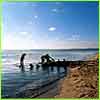

Artifact Identification: In 1989 laws were enacted requiring permits for archaeological investigations on State lands (C.G.S. Sec. 10-386). This makes unauthorized removal of artifacts from many underwater locations illegal. We recognize that many of the artifacts in private hands were acquired prior to 1989, and encourage you to share with us what you've found. In exchange for helping us develop our site database, we may be able to help you better understand the nature and history of the artifacts you possess.
Workshops & Training: We have coordinated with the Rhode Island Maritime Archaeology Project to develop a series of workshops and training sessions to teach divers proper underwater archaeological techniques. Topics include: An Introduction to Underwater Archaeology, Remote Sensing Techniques, Site Mapping Techniques and Museum Theory. For more information contact the Office of State Archaeology or visit the Rhode Island Marine Archaeology Project Web Site.
Site Database: We are developing a comprehensive site database of known underwater cultural resources including shipwrecks, plane crashes, Native American sites, submerged wharves and shipyards, etc. In order to preserve these resources, specific location data for underwater sites must remain confidential. However, if you have specific research and educational needs please contact us and we'll be happy to arrange access to site information that is in the public record.
Conservation Techniques: We do not encourage the illegal removal of artifacts from submerged sites. We do recognize that artifacts that may already have been removed have potential value that should not be lost. To help prevent the deterioration of artifacts, the Office of State Archaeology maintains files on conservation techniques that may help preserve these materials for future generations.